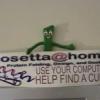At the moment, all that is “the other side of science fiction,” said Ewan Birney, director of the European Bioinformatics Institute and a member of the group that put Shakespeare’s sonnets in DNA. “Storing information in DNA is this side of science fiction.”
Dr. Church and Seth Shipman, a geneticist, and their colleagues began by assigning each pixel in the black-and-white film a DNA code based on its shade of gray. The vast chains of DNA in each cell are made of just four molecules — adenine, guanine, thymine and cytosine — arranged in enormously varied configurations.
The geneticists ended up with a sequence of DNA molecules that represented the entirety of the film. Then they used a powerful new gene editing technique, Crispr, to slip this sequence into the genome of a common gut bacteria, E. coli.
Despite the modification, the bacteria thrived and multiplied. The film stored in the genome was preserved intact with each new generation of progeny, the team found.
Andrew Odlyzko, a mathematics professor and expert on digital technology at the University of Minnesota who was not involved in the new research, called it “fascinating.”
Imagine, he said, “the impossibility of controlling secrets, when those secrets are encoded in the genomes of the bacteria in our guts or on our skins.”
The renowned physicist Richard Feynman proposed half a century ago that DNA could be used for storage in this way. That was long before the molecular biology revolution, and decades before anyone could sequence DNA — much less edit it.
“Biology is not simply writing information; it is doing something about it,” Dr. Feynman said in a 1959 lecture.
We’ll bring you stories that capture the wonders of the human body, nature and the cosmos.
- SEE SAMPLE
- MANAGE EMAIL PREFERENCES
- PRIVACY POLICY
- OPT OUT OR CONTACT US ANYTIME
“Consider the possibility that we too can make a thing very small which does what we want!”
Dr. Feynman’s idea “was a seminal piece — it gave us a direction,” said Leonard Adleman, a mathematician at the University of Southern California and co-inventor of one of the most used public cryptography systems, RSA (the A is for Adleman).
In 1994, Dr. Adleman reported that he had stored data in DNA and used it as a computer to solve a math problem. He determined that DNA can store a million million times more data than a compact disc in the same space.
And data storage is a growing problem. Not only are significant amounts being generated, but the technology used to store it keeps becoming obsolete, like floppy disks.
DNA is never going out of fashion. “Organisms have been storing information in DNA for billions of years, and it is still readable,” Dr. Adleman said. He noted that modern bacteria can read genes recovered from insects trapped in amber for millions of years.
For Dr. Shipman and Dr. Church, the immediate challenge is the brain. It contains 86 billion neurons, and there’s no easy way to know what they’re doing.
“Right now, we can measure one neuron at a time with electrodes, but 86 billion electrodes would not fit in your brain,” Dr. Church said. But gene-edited bacteria would “fit very nicely.”
The idea is to have bacteria engineered as recording devices drift up to the brain in the blood and take notes for a while. Scientists would then extract the bacteria and examine their DNA to see what they had observed in the brain neurons.
Dr. Church and his colleagues have already shown in past research that bacteria can record DNA in cells, if the DNA is properly tagged.
“People’s intuition is tremendously poor about just how small DNA molecules are and how much information can be packed into them,” Dr. Birney said.
And while these are futuristic ideas, biotechnologies have been arriving much faster than anyone predicted, Dr. Church said.
He gave as an example the sequencing of the human genome. The first effort took years and cost $3 billion. The wildest optimists predicted that maybe in six decades each sequencing would cost $1,000.
“It turned out it was six years, rather than six decades,” Dr. Church said.
Like the Science Times page on Facebook. | Sign up for the Science Times newsletter.
A version of this article appears in print on July 13, 2017, on Page A11 of the New York edition with the headline: A Living Hard Drive That Can Copy Itself. Order Reprints| Today's Paper|Subscribe












































